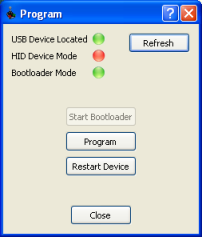 Foust, on 12 April 2013 - 01:40 PM, said:
Foust, on 12 April 2013 - 01:40 PM, said:
GenericHID makes the software part super simple and then its really just hookup the wires to the right spots.
So, I ran into a problem within the first 5 minutes, haha.
I have been searching, and it seems my problem is yet again a rare one.
I intent to use your thread as a source of help (
http://mwomercs.com/...371#entry633371), along with other pages that I searched and seem to have some detail.
But for now, I've run into some issues that just aren't clicking. For everything below, I am only requesting answers for the
BOLD questions. The other questions or comments are really just me expressing my thought process; I do not want to over-stay my welcome as far as question asking goes.
The first and positively MOST important is that GenericHID is not recognizing my device.
I downloaded GenericHID from their site, then couldn't run it due to a .dll file missing. I found that particular file in another program (JungleFlasher) on the internet, and just put it into the directory, no biggie.
I downloaded teensy loader, and it works. I click reboot, my teensy flashes. TL asks me to press the button to activate, I do as requested, and it stops flashing. In GenericHID, I pull over the Teensy Loader, a simple switch and LED (Both of which I happened to have just laying around) and wire up to specific nodes in GHID.
No matter how many times I reboot the device, program reads red for all three (USB Device Located, HID Device Mode, Bootloader Mode).
In device manager, I'm ASSUMING it's the one that reads "HID-compliant consumer control device," which has no issues.
So my question is... how do I get GHID to recognize Teensy++ ? I do NOT want to use other software if it's going to program my Teensy in an irreversible manner. I really hope I'm not supposed to do anything with Arduino, C++, or hex.
Second, I am not too keen on the understanding of this hardware. My understanding of electricity is "all circuits must be closed," and "all circuits must be grounded." That's really it. The website for the Teensy isn't all that informative, and I don't want to fry this thing on "hunches." I'm assuming that if I don't touch the center chip, and if I don't put an external power source to this thing, it should be ok. But I don't know the function of the +5V node and the GND node. GND probably means ground, and +5V is probably external source. But how on earth do I complete the circuit? I get wire leads come out from the joystick and onto whatever I choose on the Teensy, but I don't see how that's supposed to work if they aren't completed. Buttons COMPLETE circuits; they don't shoot signals or electrons out of their own source.
So, taking a step back. My question is this: to which nodes should an LED and a switch be wired in order to get started testing?
Me? Based on this chip and my knowledge of electricity, I would think to wire one lead off of a switch to the GND, and the other to a random node (say, C7). I would then take each end of the LED and wire them to random nodes (say F6 and F7). Problem is, what's going on in Generic HID? The switch has one lead labelled "In" and the other, I can't tell. My knowledge of electricity dictates that that symbol is voltage source. This doesn't quite make sense to me; does the Teensy not supply it's own power (Maybe that's what the +5V means)? How is this circuit completed? I WOULD just jump the LED to the switch, and then each of those ends could go to the teensy (In whatever configuration that would work), BUT GHID does NOT appear to support wiring between devices; devices can only be wired to the board (which is ok). Thinking about it now, that +5V is probably the start lead and GND is the end lead, which would make sense. That means that GHID shows a switch and an LED. Switch has one lead on +5V (Vcc), and another on some node. Then LED can either be both on different nodes, or one on the same node as the non +5V node as the switch, and the other on some other node.
If I don't have enough squares (When everything comes together), I can just jump from the letter sections of the breadboard to the "+-" sections.
I don't really have a question for this paragraph, considering I can just test this out once the controller can be recognized. I'm not asking for the work to be done for me; this is still a tinkering experiment.
I don't remember where, but I think I read something about Teensy supporting 8 analog controls. Is that what PA0-PA7 is for? And with respect to what Loc Nar was saying about ABSOLUTE and RELEVANT, would it then make more sense to NOT have analogue for this controller? PA0-PA7, PE4, PE5, ALE, and the three bottom ones (RST, GND, +5V) are not placed on the sides, so I don't know if they perform a specific function, or if they are "special." I suppose that will all come together on its own.
Thanks again for reading through this block hardship. That first question is really important; without recognition of my Teensy, I can't solve any other problems on my own =/
Edited by SaintApoc, 15 April 2013 - 01:54 PM.

























